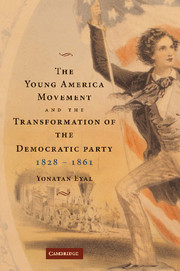Book contents
- Frontmatter
- Contents
- Acknowledgments
- Introduction: The Spirit of Young America
- 1 Orthodox Jacksonianism, 1828–1844
- 2 Trade and Improvements: The Economic Orientation of Young America Democrats
- 3 Rails, Canals, and a New Commercial Spirit
- 4 Young America Democrats and the Revolutions of 1848
- 5 A New International Consciousness
- 6 The Fires of Perfection Revisited
- 7 The Antislavery Democracy
- 8 New Democrats and the Coming of the Civil War
- Conclusion: Lincoln on Young America
- Index
3 - Rails, Canals, and a New Commercial Spirit
Published online by Cambridge University Press: 31 July 2009
- Frontmatter
- Contents
- Acknowledgments
- Introduction: The Spirit of Young America
- 1 Orthodox Jacksonianism, 1828–1844
- 2 Trade and Improvements: The Economic Orientation of Young America Democrats
- 3 Rails, Canals, and a New Commercial Spirit
- 4 Young America Democrats and the Revolutions of 1848
- 5 A New International Consciousness
- 6 The Fires of Perfection Revisited
- 7 The Antislavery Democracy
- 8 New Democrats and the Coming of the Civil War
- Conclusion: Lincoln on Young America
- Index
Summary
The transatlantic achievement of free trade and the local expansion of federally sponsored internal improvements remained the most obvious markers of New Democrats' commercial dynamism. By lowering protective barriers, young Democrats allowed economic ties with Europe and its colonies to flourish. These connections in turn led to a greater desire for political involvement in Continental affairs, especially following the failed revolutions of 1848. Similarly, by relaxing the constitutional barriers to federal funding of important national infrastructure, New Democrats contributed to the growth of a national market. In their eyes, these priorities went hand in hand, as domestic commodities traveling on cleaner lakes and faster rails demanded foreign outlets with sympathetic trade conditions.
In addition to these specific policy initiatives, Young America Democrats celebrated the growth of the market in more general terms. Through speeches, articles, and correspondence, they gave notice that the Democracy no longer frowned on stocks and corporations, banks and businesses. Beyond individual congressional measures, in other words, New Democrats displayed their heightened interest in commercial exploits in a variety of ways. Often these signals came explicitly, in the form of remarks introducing a new party agenda. At other times they slipped in unnoticed, as when an investor, in passing, expressed frustration at the traditional course of the Democratic Party. In both ways, leading Democrats showed that they were becoming restive about the Locofoco economic ideology of the 1830s, and eager to reach the imagined commercial utopia of the 1840s and 1850s.
- Type
- Chapter
- Information
- Publisher: Cambridge University PressPrint publication year: 2007



